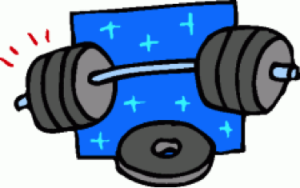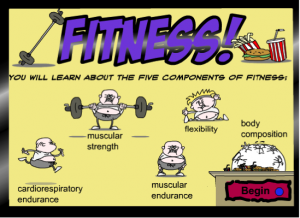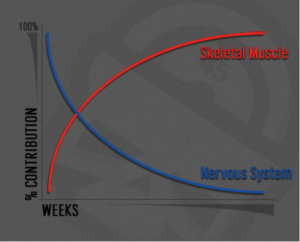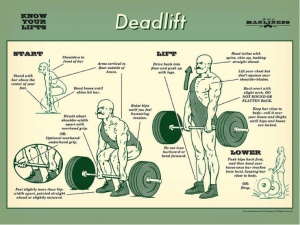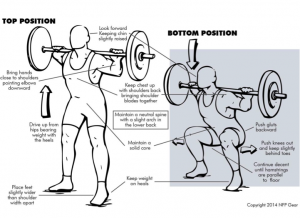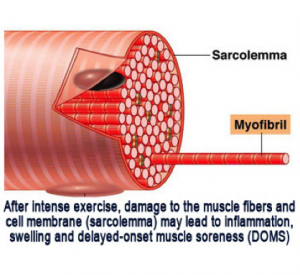Before a novice weight lifter can begin to ponder about gaining lots of muscle or expect major improvements in strength right away, there are factors that he/she has to take into account. In order to reach the maximum potential of increased muscle size and improvement with each subsequent training sessions, factors such as genetics, and overall health have to be acknowledged. Genetics is a factor that we can do nothing to change. However, overall health is key because this aspect includes cardiovascular health, dieting and sleeping habits. Good cardiovascular health is important for efficient blood flow to muscles in order to deliver nutrients for proper recovery after exercise. A good diet is important for proper nutrients to be consumed to promote muscle growth. Lastly, sleeping enough and getting enough rest is important for protein synthesis and muscle growth.
Components of fitness
In addition to the factors listed above, we also have to account for the component of fitness that the individual is aiming for when lifting weights. The major components of fitness include: muscular power, muscular strength, muscular endurance, or cardiorespiratory fitness. (Cardiorespiratory endurance will be covered in my next blog). Briefly touching on each component of fitness, beginning with muscular power, the goal is to lift weight fast and garner an explosive movement with the lift; the lifter would want to decrease the time of muscle contraction. In comparison, muscular strength requires the lifter to lift as much weight as possible without factoring in speed of contraction. Lastly, with muscular endurance, the lifter would want to improve the duration of muscle contraction during the exercise.
Because of these different components of fitness, different volumes of training have to be prescribed to meet each respective component. The repetitions, sets and recovery time used for muscular strength is typically 3 sets of 6 repetitions @ 90% of 1RM with 2-3 minutes of rest. The volume for muscular power is usually 3 sets of 2-3 repetitions with 3 minutes of rest, emphasizing speed of contraction & explosive movement. Lastly, muscular endurance volume is 2-3 sets of 15+ repetitions with <1 minute of rest. With any component of fitness chosen, there will always be some sort of muscle hypertrophy. However, one can expect more size and a faster gain in muscle size for muscular strength focused workouts, compared to endurance focused.
Novice resistance training expectations
Because a novice lifter has not been exposed to lifting weights before, their improvement (in both nerve input and muscle size) will be more dramatic than an experienced lifter. However, when a novice first starts to lift, he or she should not expect to see hypertrophy right away. Instead, the nerve input or neural factors must be developed first in order to lay the foundation for proper excitation into the muscle to perform work. As a result, within the first few weeks of beginning resistance training, the novice will be able to lift a lot heavier weight than to start, but see relatively little change in size. The increased strength is due to the improved and increased nerve stimulus to the active muscle. After around the 8th week, when the neural factors start to peak, the novice will begin to see a more dramatic change in muscle hypertrophy. This theory is based on the fact that our body constantly cycles between neural and hypertrophy. After hypertrophy is peaked, the muscles need to establish a stronger neural conduction to make the muscle contractions more efficient. This cycle results in continual strength improvement over time.
It is also important to continue maintaining the frequency of your workouts. Simply create a schedule consistent with your daily life! Without a proper schedule and consistent exercise, the positive physiological improvements in both muscle hypertrophy and cardiorepiratory fitness can be lost. This loss of capacity to exercise is due to the phenomenon called symmorphosis. Symmorphosis is the hypothesis that “no more structure is formed or maintained than is required to satisfy functional demands of your life”. Therefore, if you aren’t constantly pushing yourself during exercise, or at least maintaining your trained state, your body will theoretically tell itself that it doesn’t need to work to adapt to different training stimuli. As a result, with no training stimuli present, the body won’t adapt at all, and will instead reverse its physiological changes to an untrained state.
Part of obtaining muscle hypertrophy is also making sure exercises are being performed properly. By exercising properly, you are ensuring that the proper target muscles are being used. Examples of proper techniques that one should utilize in exercises commonly done wrong are depicted in the following images:
Delayed onset of muscle soreness (DOMS)
Novice weightlifters might also find a pain that bothers them 2-3 days after they have finished resistance training. This pain is referred to as delayed onset of muscle soreness (DOMS). The pain is often perceived as a dull ache and very sore to touch. DOMS is caused by small muscle, blood vessel and connective tissue damage due to the mechanical stress to muscle during exercise. The damage is caused by the micro-tearing of muscles, which initiates a release of bodily chemical substances that stimulate nerve endings to prolong the soreness. This pain is caused by nerve endings that function as nociceptors (pain receptors) in muscle. DOMS is usually most intense in novice lifters, or those that aren’t accustomed to certain exercises, and eccentric (the lengthening of muscle tissue while it is under tension) type exercises.
Will Le BScKin Student
Pictures obtained from: http://www.artofmanliness.com/2012/12/06/know-your-lifts-deadlift/
Hsia, C.W. (2001). Coordinated adaptation of oxygen transport in cardiopulmonary disease. Circulation Journal 104: 963-969.
Rhea et al. (2003). Medicine & Science in Sports & Exercise 35(3):456-464.

